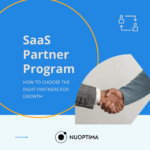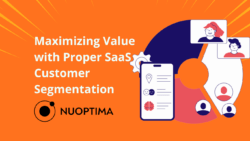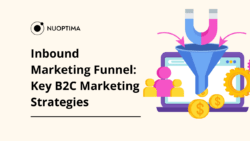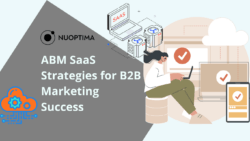It’s not enough to get new customers for your SaaS product. You also have to retain them. But that’s also not where the story ends. To run a profitable SaaS business, your customer lifetime value should be at least 3x of your customer acquisition cost.[1]
SaaS growth strategies are your best bet if you want to survive, achieve long-term success, and thrive in the SaaS market. And we will teach you how to nail it and improve your customer acquisition and retention efforts along the way. An effective way to support these efforts is through a specialized SaaS PPC approach that maximizes visibility and customer acquisition while optimizing costs.
The journey from startup to scaleup has many challenges but also opportunities if you have a keen eye and know where to look. By analyzing how some of the most successful B2C SaaS businesses have successfully scaled, we uncover practical SaaS growth strategies that will help you shorten that journey and make it a successful one.
We will delve into account-based marketing (ABM) in more detail a little later on in our article, but for enhanced insights, check out the video below from our Founder, Alexej Pikovsky. In this YouTube video, Alexej shares seven top ABM strategies, which have proven personally effective to him in his professional career as a business owner and Founder of our marketing agency.
Main Challenges for SaaS Growth
The key isn’t only to start growing your SaaS but to practically endure that growth. Why do we say that?
Growth Endurance
While SaaS businesses with ARR between $1 million and $10 million demonstrate an impressive average growth rate of nearly 200%, which notably diminishes to 60% as companies surpass the $100 million threshold. [2]
This trend underscores the concept of growth endurance, defined as the ability to sustain growth rates year over year. And if you want to enjoy your success rather than endure it, it’s an imperative to set the foundation for your SaaS growth.
Customer Retention
The first step is the obvious one – increase your subscriber base. But don’t forget that retention is extremely important for the growth of SaaS businesses like yours, making it one of the best strategies for staying on top even in turbulent times. To further enhance your retention efforts, working with a specialized SaaS email marketing agency can help streamline your approach and improve communication with your existing customers.
Data shows that companies with stellar retention rates grow at least 2.3 times faster than their counterparts. However, a higher growth rate can sometimes lead to a higher churn rate, especially in early-stage B2C companies. [3]
Seasonality
Another thing you should keep in mind when developing your SaaS growth strategies is seasonality, which can sometimes drastically impact buyer behavior.
For example, you can see a dip in traffic and conversions during holidays, right before Black Friday, and depending on your specific product, in some other periods as well.
We work with SaaS companies like yours and see it all the time. This dip is usually due to buyers expecting and patiently waiting for greater discounts during Black Friday and because they would rather spend money on their friends and family during the Holiday season than on SaaS products.
9 Leading SaaS Growth Strategies in 2025
To fulfill your potential for SaaS growth, you can’t pick one strategy and go with it. You need to understand the broader context of how these strategies affect your bottom line and influence important metrics and how they are all interconnected.
Let’s examine these SaaS growth strategies, what you should focus on, and how to implement them correctly to increase customer acquisition and retention while bringing the costs down.
SEO & Content Marketing
SEO and Content Marketing involve creating high-value, product-led content that addresses the specific needs and pain points of your target audience. But what does this mean in real life?
If you’ve done everything correctly, your content marketing strategy combined with SEO best practices will position your SaaS as the solution to your customers’ problems. However, the road from the beginning to achieving these results is often bumpy.
That’s why we’ve prepared all the essential elements and examples of how some of the most successful B2C SaaS businesses do it.
Keyword Research and Optimization
Start by identifying the keywords that your target audience uses when searching for solutions your software provides. Incorporate these keywords into your website’s content, including blog posts, landing pages, and FAQs, to improve search engine rankings and attract relevant traffic.
You can use tools like Semrush and Ahrefs to find relevant opportunities and make data-based decisions to help you grow.
Example
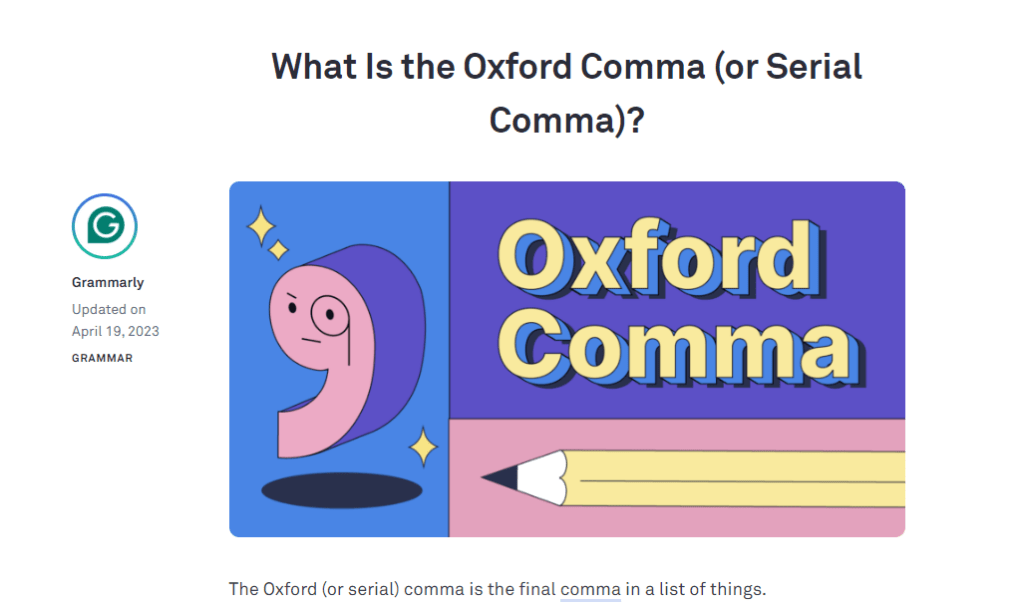
For example, Grammarly, an AI-powered writing assistant, uses targeted keywords around writing, grammar checks, and productivity tools. Their content is well-optimized for search engines, leading to high organic traffic and user acquisition rates.
Their SaaS growth strategy is to utilize keywords their audience is searching for and produce content that solves their audience’s problems. But they also incorporate product-led SaaS content strategy, offering readers an even easier solution.
Their customers won’t have to consider whether to put an Oxford comma and where; Grammarly does it for them. The point is – the reader now knows Oxford comma rules, but Grammarly encourages them to use their product instead of spending time proofreading everything they write.
High-Quality Content
Content isn’t just putting a bunch of blog posts on your website. Video tutorials, infographics, and case studies—these are all content pieces you can publish to attract new customers, help your current customers, and improve your retention. Boosting SaaS conversion rate with content isn’t a far-fetched dream but a reality if you do it right.
To achieve that, create personalized content experiences based on user behavior and preferences. This could mean recommending content based on what a visitor has previously viewed or interacted with on your site.
Example

While primarily a streaming service, Netflix provides a great example of using content personalization to engage users. Their suggestions are based on viewing history, enhancing user engagement and satisfaction, and driving 75% of viewership. [4]
But how does Netflix do this? Netflix uses machine learning as a central component of its growth strategy and delivers personalized content recommendations to its users. Their Senior Research Engineer, Kevin Mercurio, says:
“We don’t just want users to take an action, but we want them to take that action because of something that our system is doing.”
By incorporating machine learning, Netflix helps its users get the most out of their subscriptions, spending less time browsing and more time consuming the content. This approach effectively helps them increase customer satisfaction and engagement with their product while also retaining subscribers and reducing SaaS churn rate—key metrics for any SaaS business.
When to Use It?
SaaS content marketing and SEO are ideal for building long-term organic growth, increasing brand visibility, and establishing thought leadership. Use when you want to attract new customers through informational and educational content that ranks well in search engine results.
For businesses looking to enhance their local visibility, implementing effective local SEO strategies can be a game-changer.
Social Media Marketing
Social media is another channel where you can attract new customers by sharing valuable content and driving traffic to your website, where visitors can convert. The first step in truly utilizing the full potential of social media marketing is to use platforms your audience spends time on.
For most B2C SaaS businesses, platforms like Facebook, Instagram, and Twitter are where their audience spends the most time and loves consuming a specific type of content these businesses share. However, it’s important to consider the role of dark social—the hidden part of social media where content is shared privately through messaging apps and emails, making it difficult to track but crucial for brand engagement.
Example
Spotify effectively uses Instagram and Twitter to engage with its audience by sharing playlists, promoting new features, and collaborating with artists. Another great SaaS growth strategy they use is prompting customer engagement by connecting with them through music in a funny way.

Which leads us to another important aspect of your social media growth:
Create Engaging Content
You don’t want your audience to perceive you as another boring business on social media.
Because of that, you need to post content that resonates with them and encourages interaction. Besides tutorials, testimonials, behind-the-scenes, and user-generated content, your goal should be to create content that entertains and engages.
To create engaging content on social media, you need to “gamify” your product and give it a fun twist. There are a couple of ways to do this, but one of the best is to create and promote interactive content that encourages user participation and sharing. This could be through quizzes, polls, or contests specific to your product or industry.
A social media manager can also give your audience a behind-the-scenes look at your operations to build interest and engagement and humanize your brand.
Where appropriate, use a light-hearted tone or humor in your posts to increase engagement and shareability.
Besides sharing valuable information or insights related to your industry that can educate your audience, you can create regular prompts or challenges that invite daily interaction, keeping your audience engaged with your brand consistently.
Example
Have you ever heard of the Duolingo owl? Who didn’t, right?
Duolingo has gained a reputation for its quirky and humorous social media presence, particularly on Instagram. They create memes, engage in trends, and use light-hearted content to make language learning fun and engaging.

Paid Social
Social media platforms offer powerful targeting tools that can help you reach a specific audience. Use paid ads to increase brand awareness and drive conversions with retargeting ads to make the most out of your SaaS social media presence.
If you want to determine whether your paid social campaigns drive significant growth, you have to know the benchmarks and compare your metrics with them.
One of the most important metrics is definitely conversion rate, and for the B2C SaaS market median conversion rate for Facebook Ads is 2.7%. [5] You should aim for a higher conversion rate by creating multiple ad sets, A/B testing them, and optimizing your ad budget accordingly.
Example
Once again, Netlix excels at using paid social to fuel its SaaS growth and increase their subscriber base. How? They target users based on their behavior online, such as those who have visited their website but did not sign up. Retargeting ads are used to recapture the interest of these visitors, often showcasing compelling trailers and user testimonials about the service.

When to Use It?
This SaaS growth strategy is best used to engage with your audience more directly and personally. It is effective for building brand awareness, promoting community engagement, and driving traffic from platforms where your target audience is active.
Email Marketing for Retention and Upselling
Targeted email campaigns are one of the best SaaS growth strategies that serve a dual purpose: to engage your current customers and upsell to them to increase their lifetime value. At this point, you already have a decent subscriber base and it’s time to focus on long-term growth.
- Divide your customer base into distinct segments based on their behavior, preferences, and stage in the customer journey. Tailored emails that address these segments’ specific needs and interests lead to higher conversion rates.
- Keep your customers informed about new features, updates, tips, and industry news through regular newsletters. This maintains a continuous connection between your brand and the customers, reinforcing their decision to stay subscribed.
Canva uses email newsletters to celebrate user achievements and inform them about new templates, features, and design tips, effectively keeping users engaged and encouraging them to try new tools that might require premium features.

- Send tutorials and how-to guides that help customers get the most out of your product. Churn is often the main culprit for hindering SaaS growth, and the median churn rate for SaaS is 3.5%.[6] But don’t worry, as educational content helps reduce churn by ensuring users understand and utilize your product effectively.
- Identify growth opportunities to upsell or cross-sell by analyzing customer usage patterns and preferences. Send targeted offers that suggest upgrades or additional products that complement what they are currently using.
Dropbox often sends offers for additional storage or enhanced features, such as more sophisticated sharing options and security features, tailored to the customer’s use of the service.

- Design targeted campaigns to re-engage users who may have decreased their usage or are at risk of churning. Offer special promotions or highlight key features that may rekindle their interest.
Audible sends re-engagement emails offering exclusive discounts or free audiobooks to users who haven’t made a purchase in a while, enticing them to reactivate their subscription.
- Send personalized emails celebrating milestones like the anniversary of a customer’s signup or after completing a major project using your tool. These emails are great to create positive touchpoints and enhance customer loyalty.
Strava sends milestone emails to celebrate achievements like completing a certain number of runs or biking a new long distance, encouraging users to share their achievements on social media.
When to Use It?
Utilize this SaaS growth strategy to keep your user base engaged, informed about new features, and more likely to upgrade their existing plans.
ABM
While Account-Based Marketing (ABM) is traditionally associated with B2B SaaS growth strategies, B2C SaaS businesses can also adapt ABM principles to target specific customer segments that have high potential value, leveraging personalization to enhance customer experience and drive growth.
- Start by analyzing your customer base to identify high-value segments. These could be users who frequently purchase, have a high lifetime value, or show potential for upselling and cross-selling. Use data analytics to understand their behaviors, preferences, and needs.
- Create marketing messages that are specifically tailored to the needs, preferences, and behaviors of these high-value segments. Personalization at this level ensures that the marketing efforts resonate more deeply and are more likely to result in conversions.
- Use targeted advertising campaigns on social media and even SaaS PPC to capture the demand of high-value segments. Use the data you’ve gathered to craft ads that speak directly to their specific needs and interests.
- Provide exclusive offers or early access to new features for these segments. Such perks not only improve customer satisfaction and retention but also encourage upsells.
Examples
Spotify uses a type of ABM by creating personalized playlists and recommendations based on individual user behavior. While it is a broad strategy that applies to all users, the high degree of personalization can be seen as an ABM approach within a B2C context.
They target users with specific musical tastes and listening habits with personalized emails and notifications encouraging further engagement.
Amazon Prime also applies principles similar to ABM by offering Prime members exclusive benefits, targeted promotions, and product recommendations based on their purchase history and browsing habits. This targeted approach helps Amazon retain valuable customers and encourages higher spending.
When to Use It?
ABM SaaS is particularly effective for high-value B2C segments where personalized marketing leads to significant conversions.
Customer Success Programs
If you want your customers to fuel your SaaS growth, you have to root for them in the same way. That’s exactly what makes customer success programs an extremely successful SaaS growth strategy.
The first step is to develop a comprehensive onboarding process that helps new users get to grips with your product quickly and efficiently. Your job is not done when they pay for a subscription. If you want them to stay, provide them with tutorials, video guides, and FAQs to make the learning curve as smooth as possible.
Another important aspect is developing proactive rather than reactive customer support. This involves reaching out to customers to offer help before issues arise. This can include checking in regularly, providing tips on how to better utilize your product, and sending customized advice based on user behavior.
Example
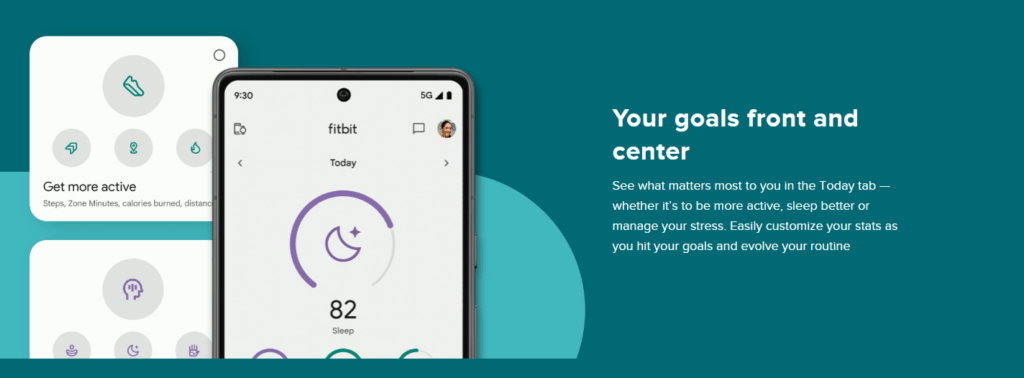
Fitbit offers a comprehensive customer success program that exemplifies effective engagement in the B2C SaaS space. This program is centered around Fitbit Premium, which provides personalized insights, wellness reports, guided programs, and coaching based on user activity data collected by their devices.
The program aims to help users achieve their fitness and health goals by offering tailored recommendations and support. Fitbit’s approach to customer success goes beyond the device; it ensures users receive continuous value through customized health and wellness advice, significantly enhancing user retention and satisfaction.
When to Use It?
When you want to increase customer satisfaction, reduce churn, and boost customer lifetime value. This is for ensuring customers achieve their goals with your product.
Referral Program
Transforming existing customers into brand ambassadors is a powerful SaaS growth strategy for a reason. It’s like word-of-mouth marketing but on steroids.
Offering incentives for referrals not only motivates current users to share your product but also taps into their networks to acquire new customers organically. This strategy capitalizes on trust and can lead to higher conversion rates, as trusted sources recommend.
Example
Dropbox is a notable example of successful growth through a referral program. Early in its growth phase, Dropbox implemented a referral program where existing users were given extra storage space for every friend they invited who joined the service.
This strategy proved highly effective, rapidly increasing their user base and significantly lowering the cost of customer acquisition. The simplicity of the offer and the value it provided to users helped make Dropbox’s referral program one of the most famous in tech.
When to Use It?
Effective for leveraging existing customers to acquire new ones. Use this strategy when you have a satisfied customer base that can advocate for your product and you want to incentivize them to spread the word.
Duplicate Your SaaS Growth Strategies to Other Markets
If something’s working, why not multiply it? This is a potent growth strategy for scaling your business. It involves taking successful SaaS growth strategies from one market and applying them to another, potentially adjusting for local variations. Here is how to do it right:
- Start by analyzing which aspects of your current strategy have been most effective. This could include marketing tactics, SaaS sales strategy, product features, or customer service strategies. Understanding what works and why it works in your original market is important before attempting to replicate these methods elsewhere.
- Select new markets that have similarities to your original market where your successful strategies might also resonate. Look for markets with similar customer behaviors, needs, and challenges. Factors such as cultural similarities, economic environment, and technological adoption rates should be considered to predict the potential success of replicating your strategies.
- While your core strategies may remain the same, localization is key. This involves tweaking your product offerings, marketing messages, and customer interaction to align with local preferences and cultural nuances.
For instance, this might mean translating your content into the local language, adjusting your product features to comply with local regulations, or modifying your SaaS pricing models to fit the economic conditions of the new market.
Once your strategies begin showing positive results in the new market, start scaling them gradually by:
- Increasing marketing spend.
- Expanding sales teams.
- Dedicating customer support.
Example
Netflix is a prime example of successfully duplicating growth strategies across multiple markets. Originally a U.S.-based service, Netflix expanded globally by replicating its successful content streaming model.
They localized content for different regions by adding local TV shows and movies and providing multiple language options, thereby making the service appealing to a global audience. They also adapted their marketing strategies to resonate with local cultures and preferences, contributing significantly to their global success.
When to Use It?
Appropriate when your current market strategy is successful, and you wish to expand into new geographic or demographic markets with similar characteristics. This strategy helps in scaling growth efficiently by replicating proven tactics.
Adjust Pricing And Selling Around Product Usage
Adjusting pricing and selling strategies around product usage is a strategic approach to SaaS growth that focuses on aligning your pricing model more closely with how customers derive value from your product.
This strategy can lead to increased customer satisfaction, better retention rates, and higher revenue per customer.
- Begin by analyzing detailed data on how your customers are using your product. Look for insights on which features are most used, which are underutilized, and how different customer segments interact with your product.
- Identify different customer segments based on usage patterns. For example, some users may heavily use certain advanced features while others might only use the basic functions.
Based on your analysis, develop pricing plans that correlate with the extent and type of usage. Common models include:
- Tiered Usage
Offer different pricing tiers based on usage levels, such as the number of active users, features used, or data consumed.
- Pay-Per-Use
Charge customers based on the specific features or services they use.
- Freemium to Premium Upsell
Start users on free plans with basic features and encourage upgrades to paid plans as their usage increases.
Pro tip: When adjusting your pricing, you have to communicate the changes clearly and effectively to your customers. Highlight how the new pricing model is fairer and aligns better with the value they receive. Transparency in how the pricing works can enhance trust and acceptance among users.
Example
Slack’s pricing model is also usage-centric, focusing on active users rather than just signed-up accounts. They provide a free version with limited features and storage, which encourages users to upgrade as they require more extensive collaboration tools and integrations. Their model effectively capitalizes on increased usage and dependency as teams grow and their communication needs become more complex.
When to Use It?
Use this strategy when you notice varied usage patterns and different customer needs within your user base. It’s ideal for aligning your pricing model more closely with the value users perceive and receive, thus maximizing revenue potential.
Partnerships
Partnerships allow B2C SaaS companies to extend their functionality by integrating with tools that complement their core offerings. These SaaS partnership strategies can be particularly effective when companies partner with others that have a similar target audience but non-competing offerings, allowing them to tap into new customer bases.
For example, a fitness tracking app could integrate with nutrition and meal planning apps to offer a more holistic health management solution. These integrations make the primary service more attractive and sticky, as customers find greater value in a seamlessly integrated suite of tools that cater to a broader range of their needs.
By partnering with companies that have a similar target audience but non-competing offerings, SaaS businesses tap into new customer bases. Each partner can promote the other’s services, effectively cross-selling to their respective user bases.
This mutual promotion amplifies reach and exposure, driving user acquisition without the high costs typically associated with finding and converting new customers.
When startups or lesser-known companies form partnerships with well-known brands, it boosts confidence among potential users about the reliability and quality of their service.
Partnerships can also include co-marketing efforts where both companies contribute resources towards shared marketing campaigns. This can include joint webinars, co-authored content, social media promotions, and bundled offerings.
Another great way to use the partnership as fuel for your SaaS growth is to consider existing platforms and networks to amplify your reach. One such tool is a list of SaaS aggregators that provides insights into which platforms align best with your product and target audience, to explore partnerships with them.
Example
A prime example of a successful partnership is between Spotify and Uber. Spotify users can integrate their accounts to play their personal playlists during Uber rides. This feature enhances the user experience for customers of both platforms, making Uber rides more personalized and enjoyable, and giving Spotify users an additional reason to prefer Uber over other ride services.
When to Use It?
When you’re looking to expand your product’s market reach, especially into new geographical areas or industries where you currently lack presence or expertise, partnering with established players can provide immediate access and credibility.
How to Measure Your SaaS Growth?
When you start implementing these SaaS growth strategies, you need to determine whether they yield the results you want, especially compared to your investment. Accurate measurement helps in understanding what SaaS growth strategies are working, which areas need improvement, and how closely you align with growth targets.
But let’s trace back a few steps since you need to know what to measure first. To measure your growth, track these metrics:
SaaS Revenue Growth Metrics
- Annual Recurring Revenue (ARR)
ARR metrics provide insights into the total predictable revenue generated by your customers. They are fundamental for understanding the scale of your operations and growth over time.
Formula: ARR = Monthly Recurring Revenue (MRR)×12
If your current monthly recurring revenue from all subscriptions is $10,000, then the ARR would be:
ARR = 10000 x 12 = $120000
If you have $80,000 in annual subscriptions and $5,000 monthly in recurring subscriptions, then:
ARR=80,000+(5,000×12)=80,000+60,000=$140,000
- Average Revenue Per User (ARPU)
This metric helps determine if you are effectively upselling and cross-selling to your existing customer base by tracking revenue changes per user.
Formula: ARPU = Total Revenue in a Period / Average Number of Users During the Period
If your SaaS company generated $50,000 in revenue this month and had an average of 1000 active users during the month, the ARPU would be:
ARPU = 50000 / 1000 = $50 per user
Customer Metrics
- Customer Acquisition Cost (CAC)
This measures the total cost of acquiring a new customer, encompassing all marketing and sales expenses. A lower CAC relative to the customer’s lifetime value (CLV) indicates efficient growth. Learning how to optimize customer acquisition costs is one of the best SaaS growth strategies once you’ve built a solid subscriber base.
Formula: CAC=Total Marketing & Sales Expenses / Number of Customers Acquired
If your total marketing and sales expenses for a month are $50,000 and you acquired 500 new customers in that month, the CAC would be:
CAC= 50000/500 = $100 per customer
- Customer Lifetime Value (CLV)
Calculated by estimating the net profit attributed to the entire future relationship with a customer, this metric helps in determining how valuable a customer is to your company over time.
Formula: Average Revenue Per User (ARPU) X Customer Lifetime or as a reciprocal of the churn rate (1/Churn Rate)
CLV=ARPU X(1/Churn Rate)
If the average monthly revenue per user (ARPU) is $30 and the annual churn rate is 10%, then:
Customer Lifetime = 1 / 0.10 = 10 Years
CLV = 30x12x10 = $3600
- Churn Rate
The percentage of customers who stop using your service over a given period. Monitoring churn closely is crucial, as high churn rates can undermine your growth and revenue SaaS metrics.
Formula: Churn = (Number of Customers Lost During the Period/Total Number of Customers at the Start of the Period) X 100
If you started the quarter with 1000 customers and lost 50 customers during that period, the churn rate would be:
Churn Rate = (50/1000) X 100 = 5%
ROI
- Return on Marketing Investment (ROMI)
Calculate the return on investment from specific marketing campaigns to see which ones are most effective at driving growth.
Formula: ROMI = ((Cost of Campaign – Gross Profit from Campaign) / Cost of Campaign) X 100
If a marketing campaign generated $100,000 in revenue and the cost of goods sold was $40,000, the gross profit would be $60,000. If the campaign cost $20,000, then:
ROMI = ((60000-20000)/20000) X 100 = 200%
- Sales Efficiency
Monitor the productivity of your sales team and the effectiveness of your sales strategies by looking at metrics like the sales cycle length and the win rate.
Formula:
- Sales Cycle Length=Total Days to Close All Deals÷Number of Deals Closed
- Win Rate = (Number of Sales Won/Total Number of Sales Opportunities) X 100
If your team had 100 total sales opportunities and won 25 of them, the win rate would be:
Win Rate=(25/100)x100=25%
This indicates that 25% of opportunities resulted in sales.
Examples of Succesful SaaS Growth Strategies Implemented
Canva
Canva has excelled in creating a large resource library full of engaging and educational content that not only helps users learn how to make the most of the platform but also boosts SEO. Their strategy includes optimizing content for various design-related keywords and providing valuable templates that attract non-designers seeking to create professional-grade materials.

Market Expansion
Canva initially targeted amateur designers but quickly expanded to cater to professionals, educators, and enterprises by adding specific features and resources that meet each segment’s unique needs, significantly broadening their market base. Now, everyone who wants to create something quickly uses Canva, even professionals.
Adobe
Adobe shifted from selling perpetual software licenses to a subscription-based model, which dramatically changed their revenue model and customer engagement strategy. This allowed Adobe to offer a lower entry price point, expanding their market to include amateur creatives, freelancers, and small businesses, while also increasing their ARR from existing professional users.
The shift from lifetime licenses to a subscription-based model was a winning one for Adobe, because they grew their ARR from approximately 4 billion dollars in 2012 to more than 19 billion dollars in 2024. And that’s the exact period when they made the shift that allowed them to grow more than 10% YoY.[7]
Conclusion
SaaS growth is a little bit like cooking. You can’t utilize every SaaS growth strategy and expect outstanding results. You have to get the recipe right first. And the best chefs have to think outside of the box and innovate.
That’s why, based on your specific goals, you need to determine which opportunities you want to explore further to grow your subscriber base and gain a healthy YoY revenue increase. When we say “think outside the box,” we mean that you shouldn’t ignore ABM because it’s meant for B2B businesses.
Instead, think like big players and apply ABM principles to your B2C marketing efforts. Refine your approach to other strategies, network with businesses similar to yours, and create partnerships that will contribute to the growth of the whole SaaS market along with yours.
The first step is to use SEO and content marketing to build a strong foundation with high-quality, relevant content that draws organic traffic and establishes your brand as a thought leader.
Once you’ve mastered this strategy, use social media platforms where your audience spends their free time and engage them with interactive and personalized content.
Your subscriber base will start growing, and now is the right time to use email marketing to keep your existing customers engaged and informed while smoothly guiding them toward higher-value offerings.
At this point, you’ve already learned a lot, and it’s time to leverage the successes and lessons from the market you dominate to expand into new markets.
And if you’re ready to take your SaaS growth to the next level but are unsure where to start or how to integrate these strategies effectively, Nuoptima is here to help. Our team specializes in delivering tailored marketing solutions that drive growth and improve SaaS ROI for businesses just like yours.
Don’t let growth opportunities slip through your fingers. Book a call with us, and let’s explore which of our services is the best SaaS growth strategy FOR YOU.
Whether it’s SaaS SEO services, content marketing, or strategic link-building, we’ll devote our time to finding an approach that will yield the results you want.
FAQ
SaaS growth refers to the increase in adoption, revenue, and market expansion of a Software as a Service company. It’s typically measured by metrics like Monthly Recurring Revenue (MRR), customer acquisition rates, and expansion within existing accounts.
Yes, the SaaS market is experiencing significant growth, driven by increased adoption across various industries due to the flexibility, scalability, and cost-efficiency of SaaS solutions. In 2023, the SaaS market is estimated to be worth approximately 197 billion U.S. dollars. [8]
The SaaS market is expected to reach 232 billion U.S. dollars by 2024. with projections suggesting that it will expand at a compound annual growth rate (CAGR) of around 18% to 21% over the next few years. [8]
SaaS is growing rapidly because it offers businesses scalable and flexible software solutions with lower upfront costs, reduced infrastructure and maintenance burdens, and continuous updates that keep technology current without additional user investment.
References
- https://www.klipfolio.com/resources/kpi-examples/saas/customer-lifetime-value [1]
- https://www.bvp.com/atlas/scaling-to-100-million [2]
- https://chartmogul.com/reports/saas-growth-report/ [3]
- https://www.businessinsider.com/netflixs-recommendation-engine-drives-75-of-viewership-2012-4 [4]
- https://www.varos.com/ecommerce-verticals/b2c-saas-market [5]
- https://recurly.com/research/churn-rate-benchmarks/ [6]
- https://stockanalysis.com/stocks/adbe/revenue/ [7]
- https://www.statista.com/statistics/505243/worldwide-software-as-a-service-revenue/ [8]
